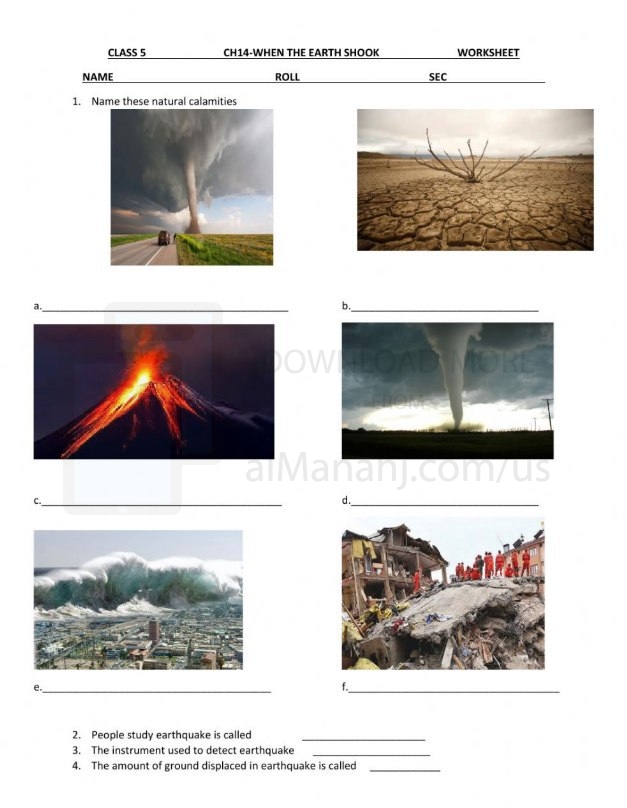| You are here: Almanahj Website ⇒ American curriculum ⇒ 4th Grade ⇒ Geology ⇒ Term 1 | ||
|---|---|---|
Worksheet about When the earth shook | ||
|---|---|---|
| Subject: Geology | ||
| 4th Grade | ||
| Term 1 | ||
| Year: 2023/2024 | ||
| Size: 359.5KB | ||
| Number of clicks: 144 | ||
| Publish date:November 27, 2023 | ||
| Added by: Eman | ||
| Last download date: 2024-09-11 21:31:50 | By: theodor Muneshdagar | |
| File info: The phrase "when the Earth shook" typically refers to an earthquake, which is a sudden shaking or trembling of the Earth's surface caused by the release of energy in the Earth's crust. Earthquakes can occur due to various geological processes, such as the movement of tectonic plates, volcanic activity, or human-induced activities. When an earthquake occurs, the ground shakes, often accompanied by vibrations and rumbling sounds. The severity of an earthquake is measured using the Richter scale or the moment magnitude scale, which quantifies the energy released during the event. Earthquakes can range from minor tremors that are barely felt to major quakes that cause significant destruction and loss of life. The effects of an earthquake can vary depending on its magnitude, depth, distance from populated areas, and the local geology. Common consequences of earthquakes include: 1. Ground Shaking: The primary effect of an earthquake is the shaking of the ground. The intensity of shaking can cause buildings and infrastructure to sway or collapse, leading to property damage and endangering human lives. 2. Surface Rupture: In some cases, an earthquake can rupture the Earth's surface, forming visible cracks or displacements along fault lines. This surface rupture can be observed as a visible indication of the Earth's movement. 3. Aftershocks: Aftershocks are smaller earthquakes that occur in the same general area as the main quake. They can continue for hours, days, or even months after the initial event, causing additional damage and hampering recovery efforts. 4. Tsunamis: Underwater earthquakes or those occurring near coastlines can trigger tsunamis, which are large ocean waves. These waves can travel across vast distances and cause devastating damage and loss of life when they reach coastal areas. 5. Landslides and Avalanches: Intense shaking during an earthquake can trigger landslides on steep slopes or cause the collapse of unstable slopes, leading to the rapid movement of debris and rocks. In mountainous regions, earthquakes can also trigger avalanches. 6. Secondary Hazards: Earthquakes can trigger secondary hazards such as fires, gas leaks, and infrastructure failures (e.g., dam failures) due to the disruption of power lines, gas pipelines, and other critical systems. It's important to note that while earthquakes are natural phenomena, efforts are made to understand and mitigate their impact. Seismologists study and monitor seismic activity to improve earthquake prediction, early warning systems, and building codes to reduce the vulnerability of communities to these events. | ||
| Downloading link Worksheet about When the earth shook |
|---|
|
1701064930.pdf
The file is being prepared for download
|
| File images |
|---|
 |